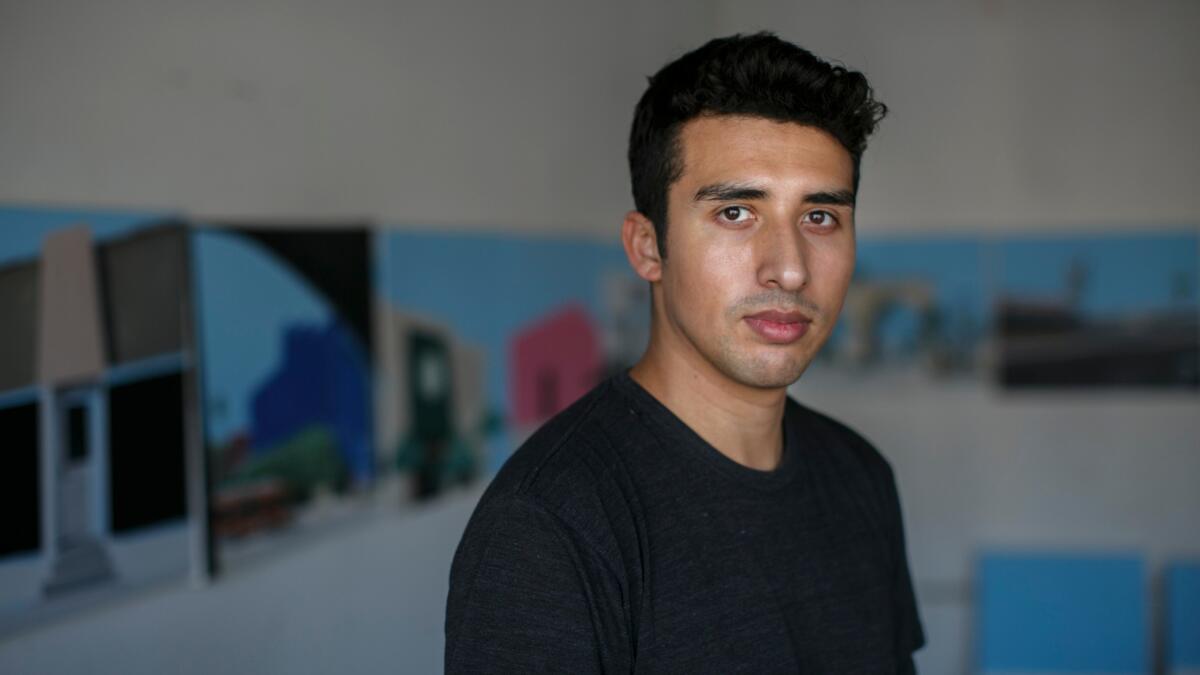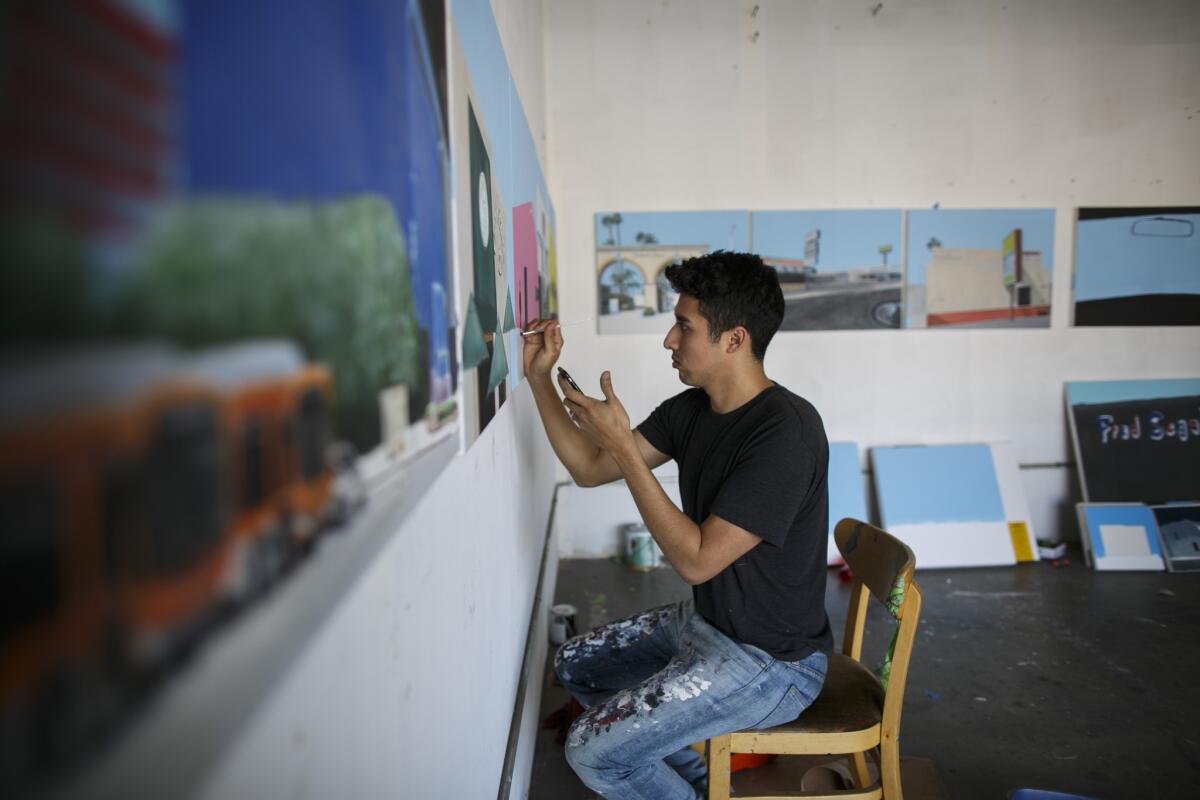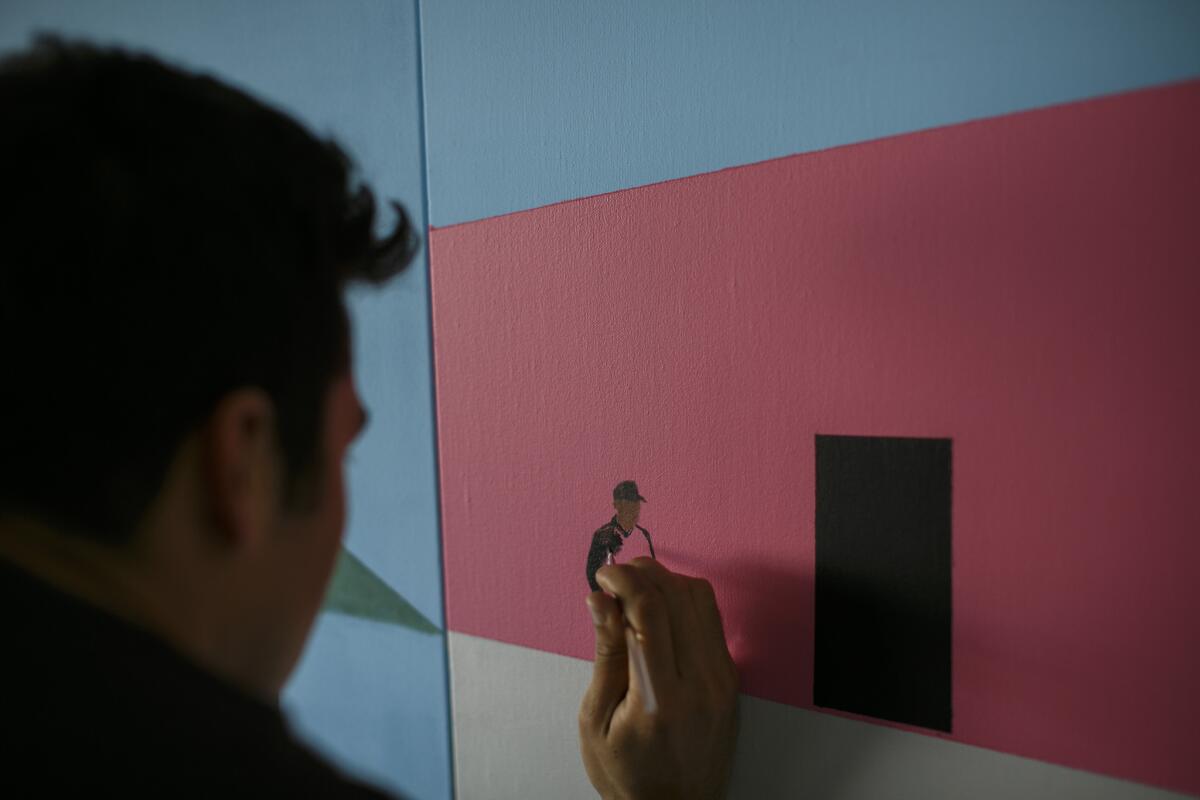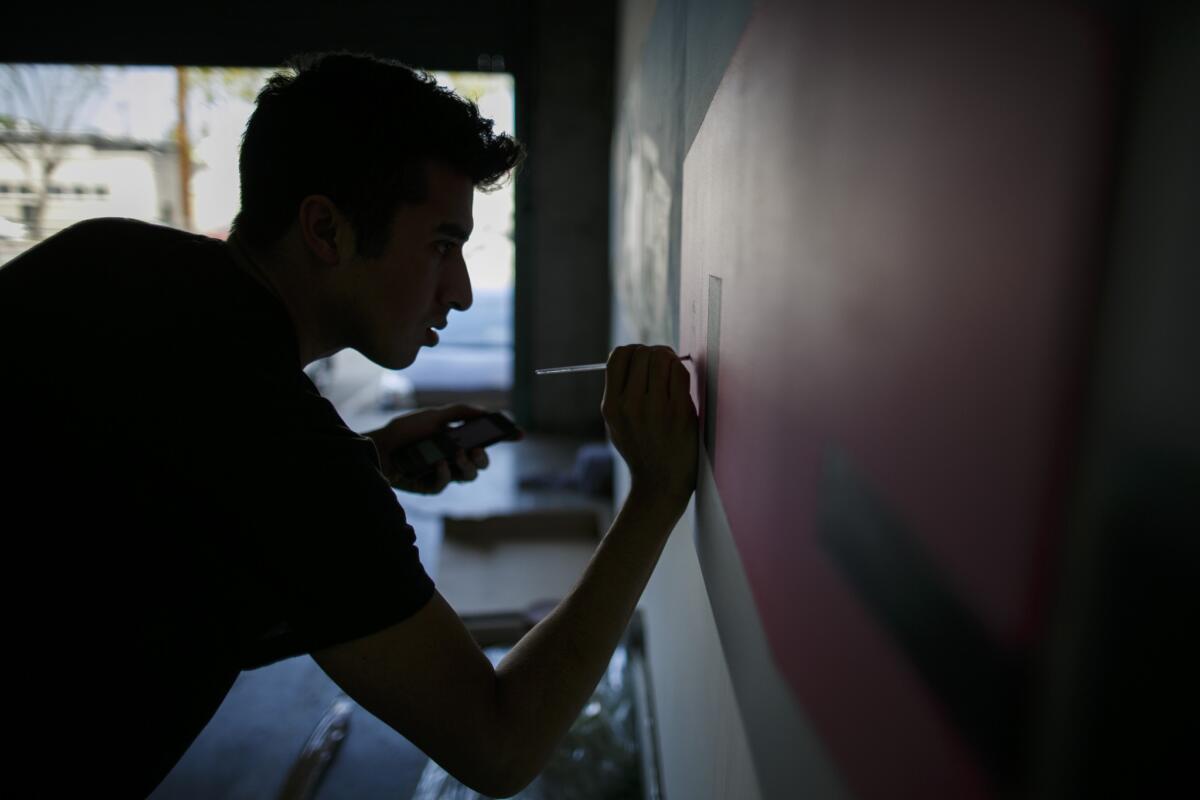Q&A: From nanny to international art star: Ramiro Gomez on how his paintings reveal the labor that makes California cool possible

Roughly five years ago, artist Ramiro Gomez was working as a private nanny for a family in the Hollywood Hills. In his spare time, he had begun making small collages that explored issues of labor. His focus: the mostly Latino nannies, gardeners, construction workers and valets who make the California dream possible to a certain moneyed set, but whose physical presence is often left out of renderings of the Los Angeles landscape.
Flash forward to the middle of last month. Gomez, now a full-time painter, was frantically putting the finishing touches on paintings for his third solo exhibition at Charlie James Gallery in Los Angeles, a series of large-scale works that place images of manual labor among the high-end retail of Melrose Avenue. On one canvas, he shows maintenance workers outside of Fred Segal. In another, he captures a security officer standing before the iconic pink boutique of British designer Paul Smith.
At the same moment, Abrams Books was releasing a monograph of his work, āDomestic Scenes: The Art of Ramiro Gomez,ā by cultural journalist Lawrence Weschler.
None of this attention, however, compares with having esteemed painter David Hockney pop into his show. Last week, the celebrated British-born painter made a pilgrimage to Charlie James to check out Gomezās work.
āFor him to take the time to stop into the gallery is incredibly meaningful,ā Gomez says. āWhat he has done in his career, and the influence he has on Los Angeles itself, is something I greatly admire. His work is relevant to many of us here and elsewhere.ā
This is no coincidence. Over the years, Gomez has reimagined a number of key Hockney works. In 2013, he remade Hockneyās 1967ās canvas, āA Bigger Splash,ā as āNo Splash,ā a piece that transformed the British artistās languid pool scene into a place of work. In the scene, Gomez depicts a man cleaning the pool, while another figure, in the distance, sweeps up the deck.
Born and raised in San Bernardino, Gomez first stumbled into Hockneyās work in a book supplied by his high school art teacher. He was immediately intrigued by the painterās work: the Modern ways in which Hockney presented Los Angeles in blocky chunks of color, all glistening pools and emerald lawns, as well as the straightforward ways in which he rendered gay male sexuality (often with men frolicking in those very pools).
But for Gomez, images of California by Hockney and other painters ā as a place of chilled-out leisure ā was something he wanted to upend. In his work, he wanted to show the manual labor that makes those luxurious environments possible, labor that he had once expended himself.
What does Hockney think of having his paintingsā imagery reworked by the 29-year-old upstart?
In the past, heās been quite OK with it. In fact, Gomez and Hockney have met in the past, a pleasant gathering chronicled in Weschlerās book.
āHeās obviously very good,ā Hockney told Weschler during that outing. āHe knows exactly where to place the figures, and his color sense is spot on.ā

Over the last three years, Gomezās work has caught the attention of the media, as well as the art world. No small irony, since the art world is often reflective of elite tastes, and therefore complicit in keeping the question of manual labor firmly out of public view. The art world is pretty lousy on the demographic front, too.
All of it is good fodder for discussion ā and, in fact, the artist will be in conversation with Weschler at the Hammer Museum in Westwood on Thursday evening to take on these matters.
In the midst of his hectic travel schedule, Gomez took time to chat about his work. In this lightly edited conversation, he discusses the ways in which workers are depicted in art, how he wants to reframe the idea of California cool, and why his new series of paintings is set on Melrose Avenue.

When you began this series, did you imagine it would generate this level of attention?
No! In fact, when I first started work on this it was purely almost as a diary ā recording my early experiences, just coping with everything I was experiencing. This is definitely a major surprise me. I think people are responding to a truth they understand already but they havenāt seen reflected through art. There are academics and organizations working with immigrant domestic labor, but the nerve Iām touching is something Iāve started investigating through art history.
Thereās this awesome quote by [novelist Charles] Bukowski: That an intellectual says a simple thing in a hard way and an artist says a hard thing in a simple way. Art is still relevant and it can still say so much in this time.
How did you end up working as a nanny?
Growing up I had a lot of experience helping with babysitting. In summer, many kids go to summer camp; Iād go to my grandmotherās house and help take care of my cousins. In high school, I took classes on early childhood education. I volunteered at the local elementary school and learned about early child care and education. At that point I saw myself as a teacher.
Right after graduating, I got a job at a local elementary school where my mom was working as a janitor. I worked there for a year or so. I was doing instructional work. [Then] I got into CalArts and I had to move. In order to make a living I found a job not too far from CalArts at a private child care center. My experiences there with younger children were vital when this job offer came to me to be a [private] nanny.
You were a nanny for two and a half years. What was that experience like?
Thereās a lot of weird boundaries that exist. We are charged with caring for the children. We are expected to provide love. We are expected to go beyond the agreed upon responsibilities. A lot of things, you just have to deal. Youāre trying to make sure the kids are happy, but youāre also trying to feel the family. Youāre trying to make sure that they arenāt upset with you. Thatās a lot of pressure.
A lot of friendships [with the women I worked with] became pivotal. Because weāre all working together, we were almost these informal family groups that came together on a weekly basis. And the following week there was a real possibility of a member not coming back or disappearing. That would really hurt.
Thatās something thatās come up in some of the scenes Iām working on: These ephemeral moments of people who appear and disappear. Invisibility goes beyond one person. It takes on a mental state. The need to blend in and not stand out too much. Youāre wanting to please. You want to make sure that there are no reasons to be fired.
What spurred you to begin painting these scenes that show domestic labor?
The chronology started with the magazine work. I would look at magazines like Architectural Digest on my break, during nap time. There was a two-hour nap time. The family I worked for, they had them laying around. As a mental break, I would look through them. Thatās where I started this: during nap time. I only had this little window within which I would work.
The magazines looked like the very environments I was working in and I started feeling an interesting reaction to them. It was looking at these environments minus all the people I was working with. It was an erasure of us. So it became very clear what to add. It was this simple act. It was just inspired by saying , āIām here. We exist.ā
Youāve also really engaged other artists in the process ā Hockney, in particular. What have you learned by reimagining his work?
Originally, when I started the magazine series, it was very much responding to the environments I was working in. But after I developed the work, I began to see Hockneyās work differently. I saw Hockneyās 1960s Los Angeles paintings in one way before the [nanny] job and one way after the job.
It was hard to look at paintings like āA Bigger Splash,ā where everyone is focused on the ephemeral moment of the splash, without thinking about the other aspects of whatās there. The painting is an amazing statement by an artist, but Iām less interested in the leisurely activity of using the pool. Iām more interested in the pool cleaner, in the housekeeper.
Culture shapes and shifts as it moves. It influences perception. That is something that Hockney has always involved himself with: perception, the ways of rendering something three-dimensional in two dimensions. With me, Iām very curious how [my] work can re-shape and re-form what people had previously seen as the California life. People tell me they canāt see Hockneyās work the same way after. That was the goal for me.

This comes from a long-running admiration of Hockneyās work. Why does it appeal to you so much?
I was drawn to him from a purely aesthetic way starting in high school, but also for the LGBTQ life he displayed so openly in his work. I had such an interest in that ā the presentation of [sexuality] in such a casual manner during a period in which it wasnāt deemed normal. I see my work in a similar way, in a climate around this election and the debate around immigration, workers are often erased and dehumanized. Iām trying to inject back the humanism. Iām trying to create a space of contemplation.
Youāve also explored the issue of labor in older art historical works ā such as Diego de Velazquezās famous 17th century canvas āLas Meninas,ā which, as you point out, is really a scene of domestic work.
āLas Meninasā is something Iāve always been drawn to. Velazquezās insertion of the artist was always very intriguing to me. And in my own work, I always felt like I was in the background of my own royal court ā the family that brought me in as a nanny. But, naturally, I feel the need to reference it and update it and recontextualize it.
Who is being featured in this painting? The actual focus of āLas Meninasā [āThe Maids of Honorā] can often get lost in other interpretations of what that painting is about. They often deal with everything but the nannies. So to focus purely on las meninas is important. Velazquez titled the painting after its subject.
Given the demographics of the art world, are you ever concerned that your work might reinforce the idea of Latinos as manual labor ā and nothing else?
That fear is there. As an artist, I want to represent truth without stereotyping and reinforcing. [But] when I hear a student from Harvard come up to me and say, āIām at Harvard because of my dadās construction jobā or āIām at UCLA because of my momās housekeeping jobā that fear subsides. Iām just putting something in a context that allows contemplation of the issue. Iām painting my own mother. Iām painting about my dad. Iām painting about myself.
I also selectively choose the facelessness [of my figures] for a reason. Most of the people I did work with were Latino, but there were people from Pakistan and other places. Plus, this isnāt just an L.A. reality. In other parts of the world, the cast is different but the reality is the same. So for people in Turkey or France or Pakistan, to see this, the issue is the same. Visualizing this labor is necessary.
So you are painting these figures as an everyman and it is us, the audience, who can choose to read them specifically as Latino?
Exactly. Exactly. I also think of the ways that housekeepers have or have not been featured throughout history. Theyāre always the invisible figure. I was watching [Woody Allenās] āBlue Jasmineā the other day and thereās a scene where a worker opens the door. They remain silent. Itās this two-second shot. And I think people are used to this. So thereās nothing better than having this art out there that challenges that.
What inspired the new series about Melrose that is currently on view at Charlie James?
āOn Melroseā is this very specific reference to my trips along Melrose, which is recognizable the world over for its buildings like Paul Smith and Fred Segal. I wanted to look at the subject of California, like I did with Hockney, but with my own compositions. I did an installation, āMelrose Avenue, Eastboundā that is a way of me going from west to east and painting about these tropes.
There are artists out there, I look at Alex Israel, that are engaging with what California is. That California is palm trees. That California is sunny weather. But I donāt come from that. I donāt see that cool. So Iām reframing. Iām choosing to include palm trees. Iām choosing to include the bright colors, like the Paul Smith building ā yet the introduction of a maintenance man before that very building reframes it so that you get a very different sense. Itās not just leisure. Itās work. Itās important to show the maintenance that allows for all of this to exist, for Hollywood to run.
āRamiro Gomez: On Melrose,ā is on view at Charlie James Gallery through May 28. 969 Chung King Road, Chinatown, Los Angeles, cjamesgallery.com.
Gomez will be in conversation with Lawrence Weschler on May 5 at the Hammer Museum at 7:30 p.m. 10899 Wilshire Blvd., Westwood, Los Angeles, hammer.ucla.edu.
Find me on Twitter @cmonstah.
More to Read
The biggest entertainment stories
Get our big stories about Hollywood, film, television, music, arts, culture and more right in your inbox as soon as they publish.
You may occasionally receive promotional content from the Los Angeles Times.











